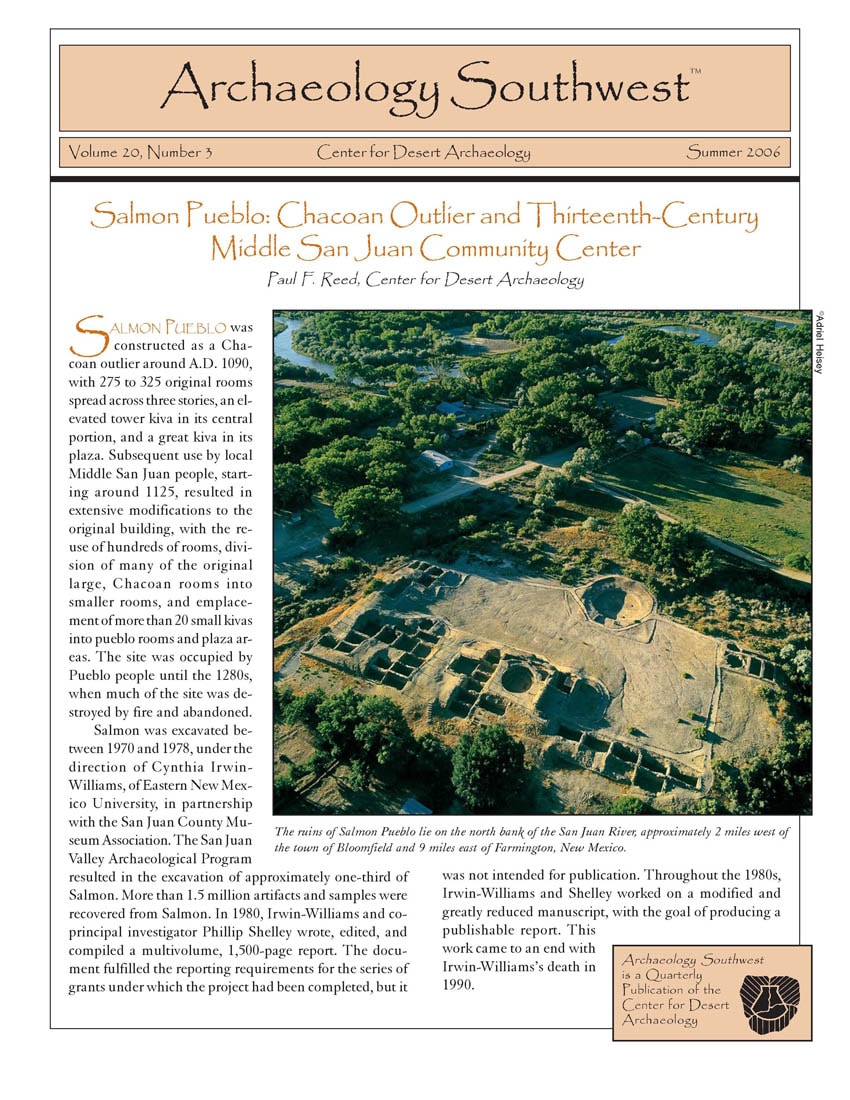Salmon Pueblo: Chacoan Outlier and Thirteenth-Century Middle San Juan Community Center

The ruins of Salmon Pueblo lie on the north bank of the San Juan River, approximately 2 miles west of the town of Bloomfield and 9 miles east of Farmington, New Mexico. Image copyright Adriel Heisey.
Archaeology Southwest Magazine Vol. 20, No. 3
FREE PDF DOWNLOAD
Issue editor: Paul F. Reed, Archaeology Southwest (formerly the Center for Desert Archaeology)
Salmon Pueblo was constructed as a Chacoan outlier around A.D. 1090, with 275 to 325 original rooms spread across three stories, an elevated tower kiva in its central portion, and a great kiva in its plaza. Subsequent use by local Middle San Juan people, starting around 1125, resulted in extensive modifications to the original building, with the reuse of hundreds of rooms, division of many of the original large, Chacoan rooms into smaller rooms, and emplacement of more than 20 small kivas into pueblo rooms and plaza areas. The site was occupied by Pueblo people until the 1280s, when much of the site was destroyed by fire and abandoned.
Salmon was excavated between 1970 and 1978, under the direction of Cynthia Irwin-Williams, of Eastern New Mexico University, in partnership with the San Juan County Museum Association. The San Juan Valley Archaeological Program resulted in the excavation of approximately one-third of Salmon. More than 1.5 million artifacts and samples were recovered from Salmon. In 1980, Irwin-Williams and co-principal investigator Phillip Shelley wrote, edited, and compiled a multivolume, 1,500-page report. The document fulfilled the reported requirements for the series of grants under which the project had been completed, but it was not intended for publication. Throughout the 1980s, Irwin-Williams and Shelley worked on a modified and greatly reduced manuscript, with the goal of producing a publishable report. This work came to an end with Irwin-Williams’ death in 1990.
In 2000, Center for Desert Archaeology staff met with Salmon Executive Director Larry Baker, and forged a multiyear partnership. The partnership is part of the Center’s effort to build a preservation archaeology network across the Southwest. The Center’s effort at Salmon began in 2001, as the Salmon Reinvestment and Research Program, which Paul Reed was selected to direct. The research initiative comprised two primary tasks: first, to condense and edit the original 1980 Salmon report into a new, published technical report, and second, to conduct additional, primary research in several targeted areas, with the goal of producing material for the detailed technical report, as well as a synthetic volume. That three-volume technical report, Thirty-Five Years of Archaeological Research at Salmon Ruins, has just been published. This issue of Archaeology Southwest Magazine presents some of the highlights of that research.
Articles include:
Salmon Pueblo: Chacoan Outlier and Thirteenth-Century Middle San Juan Community Center — Paul F. Reed, Center for Desert Archaeology
The Architecture and Development of Salmon Pueblo — Larry L. Baker, Salmon Ruins
Architectural Wood Studies at Salmon Pueblo — Thomas C. Windes, National Park Service, and Eileen Bacha, Youngstown, Ohio
Current Ceramic Research in the Middle San Juan Region — Lori Stephens Reed, Animas Ceramic Consulting, Inc.
Using Ceramic Symmetry to Understand Chacoan and Puebloan Culture — Dorothy Washburn
Skilled Farmers, Astute Naturalists, Ritual Practitioners — Karen R. Adams, Crow Canyon Archaeological Center
Ritual Uses of Textiles and Basketry — Laurie D. Webster
Animal Bones from Salmon Pueblo — Kathy Roler Durand and Stephen R. Durand, Eastern New Mexico University
Sacred Landscapes: The Chaco-Middle San Juan Basin Connection — Ruth M. Van Dyke, Colorado College
Archaeology in the La Plata Valley — H. Wolcott Toll, Museum of New Mexico, Office of Archaeological Studies
Current Research at Aztec Ruins — Gary M. Brown, Aztec Ruins National Monument
Understanding Chaco: A Digital, Archival Approach — Steve Plog and Carrie Heitman, University of Virginia
Chaco and Mesa Verde — R. Gwinn Vivian
Back Sight — William H. Doelle, Center for Desert Archaeology
Subscribe

